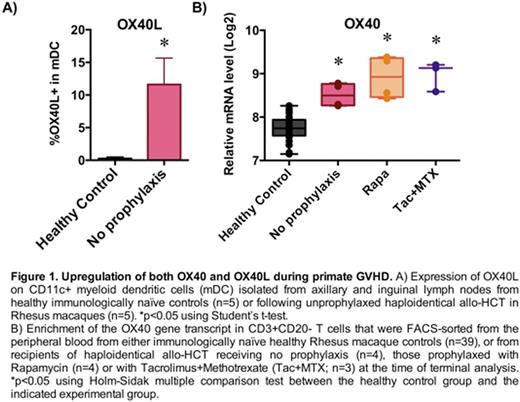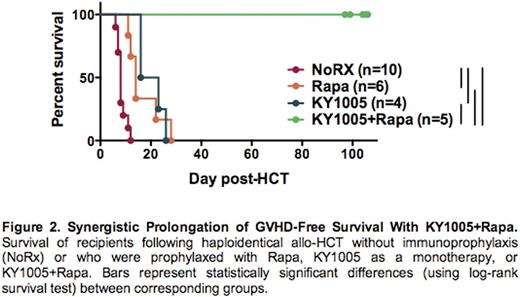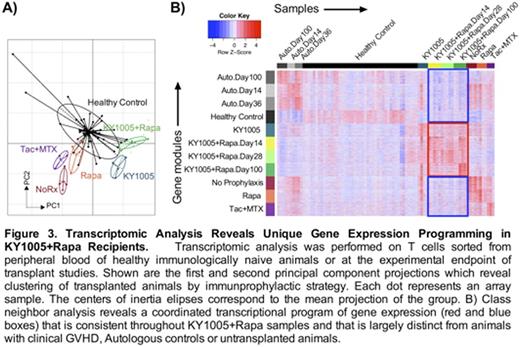Abstract
While calcineurin inhibition (CNI)-based strategies remain the mainstay for GVHD prevention, CNI are notoriously antagonistic to immune tolerance induction. Rapamycin (Rapa) has been shown to be more pro-tolerogenic; however, the best agents to combine with Rapa are still undetermined, and it remains a second-line GVHD prevention strategy without clear superiority over CNI. Finding tolerogenic partners for Rapa, therefore, represents a critical unmet need in the field. Of the possible partners for Rapa, the OX40/OX40L pathway represents an important target. OX40 is a costimulatory receptor expressed on activated human T cells, which, upon interaction with OX40L delivers activation signals to conventional T cells (Tconv) promoting their proliferation, survival and clonal expansion. Notably, these same OX40/OX40L signals may either inhibit or promote Treg functions, depending on context, suggesting that blockade of this pathway may simultaneously control Tconv activation while permitting Treg homeostasis.
During GVHD in non-human primates (NHP), we found OX40L upregulation on myeloid dendritic cells and OX40 upregulation on activated T cells in recipients treated with multiple immunosuppressive agents, including Rapa (Fig 1). These data provided strong rationale for testing KY1005, a novel human monoclonal antibody that binds to OX40L and blocks its interaction with OX40, as a potential partner with Rapa. We tested the outcomes of prophylactic blockade of this pathway on NHP GVHD, using KY1005 alone and in combination with Rapa. These experiments utilized our previously published NHP GVHD model, in which GVHD is studied after T cell-replete haplo-identical HCT. KY1005 was dosed at 10mg/kg weekly from days -2ˆ+54 and Rapa was continued through Day +100.
Prophylaxis with KY1005 alone provided initial evidence for its in vivo activity, with control of CD4>CD8 T cell proliferation and mitigation of the expansion of CD4>CD8 T effector/memory cells. Consistent with the partial control of T cell activation, these recipients demonstrated improved GVHD-free survival versus unprophylaxed controls, but disease ultimately broke through (Median Survival Time (MST) = 19.5 days with KY1005 (n=4) compared to 8 days in unprophylaxed recipients (n= 10, Fig 2)).
We next investigated the impact of OX40L blockade + Rapa. We have published that Rapa as a monotherapy minimally controlled both immunologic and clinical disease, with an MST = 14 days (n=6). Combined prophylaxis was striking: recipients given KY1005+Rapa (n=5) maintained robust health throughout the entire experiment (MST >100d), and demonstrated high levels of donor T cell chimerism (86 +/- 3% at Day 100), rapid hematopoietic reconstitution, and had a terminal GVHD Grade of 0, compared to a Grade of III-IV in both KY1005- and Rapa-monotherapy cohorts. Immunologic analysis demonstrated synergistic control of both CD4 and CD8 T cell proliferation, restoring it to the level observed during autologous immune reconstitution, and resulting in a concomitant abrogation of CD4 and CD8 memory/effector expansion while preserving T cells with a na•ve phenotype. In striking contrast to the inhibition of Tconv activation by KY1005+Rapa, recipients of dual therapy demonstrated intact Treg reconstitution post-HCT, which resulted in a favorable Treg:Tconv ratio of 5.4 vs 1.4:100 in KY1005+Rapa treated compared to untreated recipients (p < 0.05). Transcriptomic analysis confirmed the unique immunologic state conferred by KY1005+Rapa on purified T cells, with gene arrays from these recipients demonstrating separation from all other transplant cohorts in Principal Component space (Figure 3A) and Class Neighbor Analysis identifying unique expression modules that tracked with KY1005 + Rapa prophylaxis (Figure 3B red and blue boxes).
These results underscore the critical role of OX40/OX40L signaling in the development of GVHD and demonstrate the striking control of GVHD in KY1005+Rapa recipients. They represent the first demonstration of uniform, long-term GVHD-free survival in the primate model of high-risk haplo-identical HCT, and the first therapeutic strategy that simultaneously controls Tconv activation while supporting Treg homeostasis in this model. They suggest that OX40L blockade + Rapa is a novel, evidence-based combinatorial strategy to control GVHD that is an exceptional candidate regimen for clinical translation.
Tkachev:Kymab Ltd: Patents & Royalties: US Patent 9,382,325, Research Funding. Casson:Kymab Ltd: Employment. Kirby:Kymab Ltd: Employment, Patents & Royalties: US Patent 9,382,325. Bland-Ward:Kymab Ltd: Employment, Patents & Royalties: US Patent 9,382,325. Kean:Juno Therapeutics, Inc: Research Funding.
Author notes
Asterisk with author names denotes non-ASH members.




This feature is available to Subscribers Only
Sign In or Create an Account Close Modal